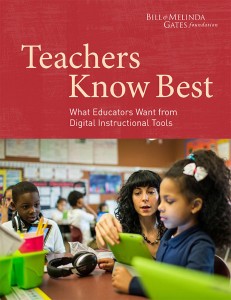 As Common Core and other school reforms roll out across the country, teachers are reporting that they continue to look for digital tools that meet up with new standards and that they trust to be effective in helping teach students at all grades.
As Common Core and other school reforms roll out across the country, teachers are reporting that they continue to look for digital tools that meet up with new standards and that they trust to be effective in helping teach students at all grades.
The findings come from a new study published by the Bill & Melinda Gates Foundation that finds that the formal school market for all digital tools – including games – continues to evolve as teachers report the need for tools that do not yet exist.
“[E]ven as the instructional market is going increasingly digital and a huge array of products exists, gaps remain: Certain types of products that teachers said they need for specific instructional purposes are simply not available; in other cases, there are products available, but teachers aren’t using them or don’t perceive them to be effective,” the report found.
These market gaps present opportunities for product developers to create new digital instructional tools or improve existing ones to better meet the needs of teachers and students.
Teachers Know Best report
Key Findings
- 58% rate free products as effective, only slightly less than the 60% who rate products bought for them by districts as effective.
- Only 4% of teachers report using their own money to purchase digital tools.
- Digital technology spending (not including hardware) saw just over $2 billion in 2012 sales and $2.5 billion in 2013.
- About 40% of currently available digital products focus on a single subject, with most focused on either math or English Language Arts.
Part of the research highlighted gaps that the teachers and researchers identified among digital products for schools. The research categorized these gaps as usage gaps where teachers don’t have their students use the available digital tools; perceived effectiveness gaps where the teacher does not feel the digital tools are that good and availability gaps where the teacher said there are no digital products.
The research went on to highlight the different areas where they saw these gaps:
- High school math and ELA (perceived effectiveness gap)
- Content-agnostic platforms that host or aggregate content (usage and perceived effectiveness gaps)
- Grades 3–8 products that cover two or three subjects (usage and perceived effectiveness gaps)
- Grades 3–8 science (availability, usage, and perceived effectiveness gaps)
The report also highlighted some opportunities for game developers looking to build science or social studies apps. The report found that there are few effective student-facing digital tools in either of these areas, but the report also found more skepticism among teachers about the effectiveness of the science tools.
Interestingly, when it comes to social studies, teachers said the digital tools are often effective, but there are not many of them, indicating there could be a market there.
Still, despite the concerns raised in the report, the authors highlight some trends that indicate the market in formal education could grow.
“There are a number of indicators that the market may grow in the next three years: Districts are piloting many digital products, as well as building up their hardware and networking capacities,” the authors write. “Districts also are expected to increase their spending on instructional materials after several years of postponing purchases due to economic conditions and the wait for the emergence of materials better aligned with the CCSS (Common Core) and the Next Generation Science Standards.”
The report included surveys of more than 3,100 teachers and 1,200 students and explored 16 different school districts.
Editor’s Note: The Gates Foundation also supports the work of the Games and Learning Publishing Council. They had no input in any content connected to this story.
